California is a large state comprising a significant portion of the western coastline of the United States. This state has been home to a variety of animals and types of people during recorded history. Yet, California was not always a land with a vast assortment of creatures. In fact, it hasn’t been dry land for that long in the geological sense. Today, we’re going to examine the dinosaurs that lived in California based on the fossils recovered from the area.
We’ll show you which of these large reptiles lived in the region and why we don’t know about many of them.
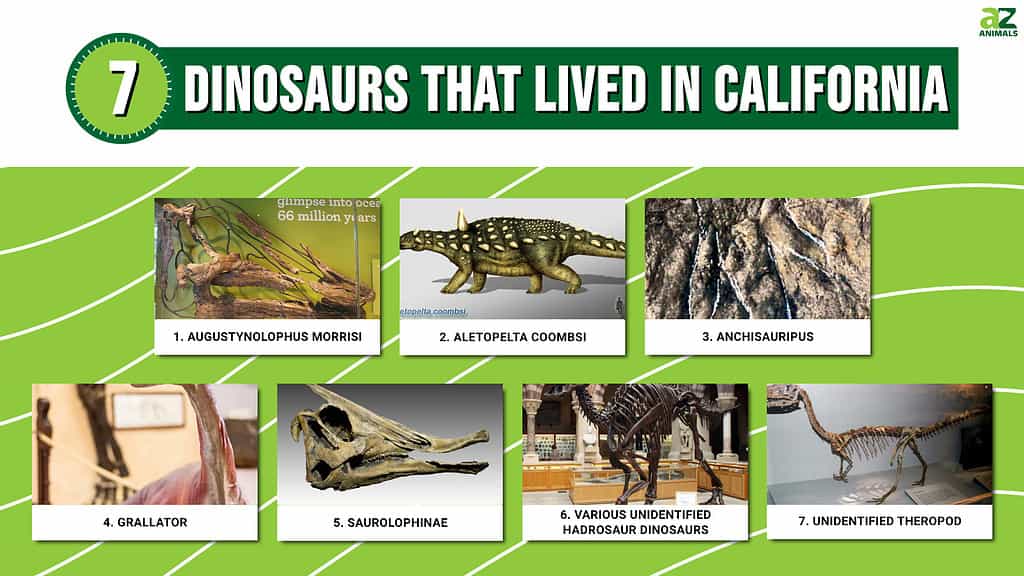
What Is California’s State Dinosaur?
California’s state dinosaur is Augustynolophus morrisi. State officials named the reptile the state dinosaur in 2017. The first fossil of this dinosaur was located in 1939 and the second one was found in 1941. Like other hadrosaurs, this creature was a large herbivore that lived at some point in the late Maastrichtian Age. That age directly preceded the extinction of terrestrial dinosaurs.
Augustynolophus morrisi could grow about 26 feet long and weigh up to 6,000 pounds. The species also had a duck-shaped bill like many other members of the Hadrosauridae family.
Now that we’ve taken a look at California’s state dinosaur, it’s time to look at the other dinosaurs that roamed the state.

California’s state dinosaur is
Augustynolophus morrisiwhich was roughly 26 feet long and weighed up to 6,000 pounds.
©Nobu Tamura email:[email protected] http://spinops.blogspot.com / CC BY-SA 4.0 – License
What Are The 7 Dinosaurs That Lived In California?
Although we are going to say that there were seven dinosaurs that lived in California, the truth is that many more of them probably roamed the land. After all, California was home to a variety of different hadrosaurs. One of them has been identified in Augustynolophus morrisi. Another fossil’s subfamily was identified, but many other fossils have not been placed in any classification beyond their family.
Thus, several other dinosaur species could have lived in California at some point. Paleontologists simply lack the fossil evidence to say which particular dinosaurs lived here.
1. Augustynolophus morrisi
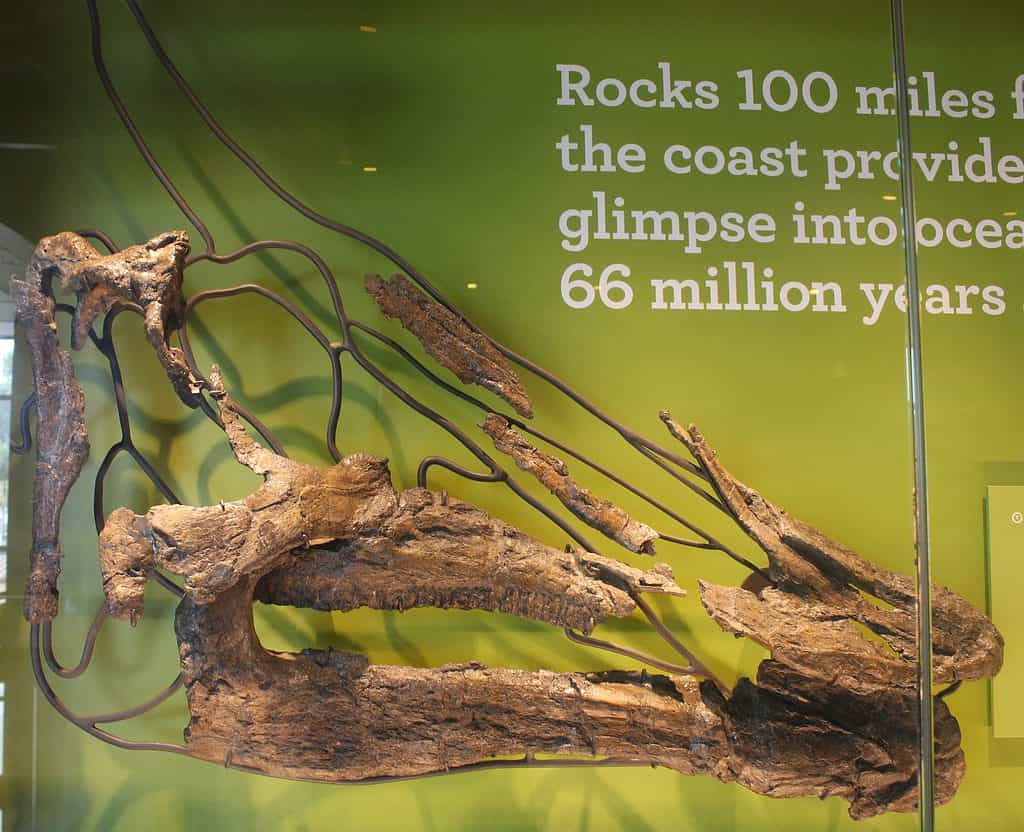
While only two fossils of
Augustynolophus morrisihave been found, they have provided scientists with a great deal of information.
©Jonathan Chen, CC BY-SA 4.0 <https://creativecommons.org/licenses/by-sa/4.0>, via Wikimedia Commons – License
First off, we have the hadrosaur, Augustynolophus morrisi. This herbivorous creature is the state dinosaur of California. Only two fossils of this creature exist. Yet, those fossils provided scientists with valuable insights about the creature.
This hadrosaur was a duck-billed dinosaur. The creature was large and could reach up to 26 feet long and weighed about 6,000 pounds or more. Augustynolophus morrisi probably walked mostly on four legs, but it was capable of balancing on its back legs to rear up and get higher vegetation. This may have been the largest of the dinosaurs that lived in California.
Evidence of this dinosaur comes from the Moreno Formation in California, specifically San Joaquin Valley.
2. Aletopelta coombsi
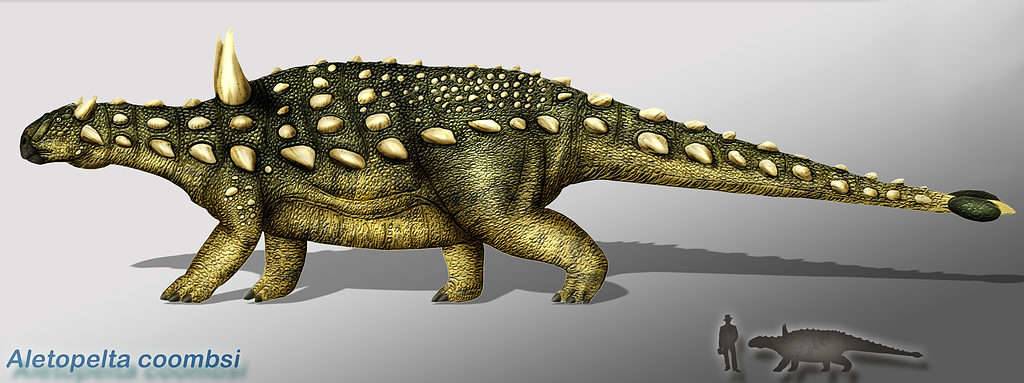
was a short, heavy, and armored dinosaur discovered in California.
©Karkemish, CC BY 3.0 <https://creativecommons.org/licenses/by/3.0>, via Wikimedia Commons – License
Aletopelta coombsi was discovered in the Point Loma Formation of California. This creature was an ankylosaurid, a short, heavy, and armored dinosaur. This quadrupedal herbivore could have weighed as much as 4,400 pounds and grown about 16 feet long. Due to the lack of fossils of this dinosaur, it’s hard to know much about it other than its size, the fact that it was armored, and other information inferred from the suborder to which it belongs.
3. Anchisauripus

Fossilized tracks of an ichnogenus like this one found in Italy, were found in the Mojave Desert.
©Hectonichus, CC BY-SA 3.0 – License
You may not have heard of Anchisauripus before. After all, Anchisauripus is an ichnogenus, meaning that this taxonomic group is only known by fossilized tracks that it left behind. Paleontologists believe that Anchisauripus was a small theropod. The dinosaur’s tracks were found in Jurassic-era sandstone in the Mojave Desert. Very little is known about these carnivores other than they were small, light theropods.
4. Grallator

The
Grallatoris known only by the fossilized tracks it left behind.
©Benjamin Clapp/Shutterstock.com
Grallator is another ichnogenus that is only known by the tracks the creature left in the ground. Like the tracks of Anchisauripus, James R. Evans discovered the Grallator tracks in the Mojave Desert.
Scientists know little of these Jurassic-era creatures other than they were small, light theropods that were most likely carnivores. Interestingly, the representative of the San Bernardino County Museum who analyzed the tracks was not able to place the third set of tracks in a family.
5. Saurolophinae
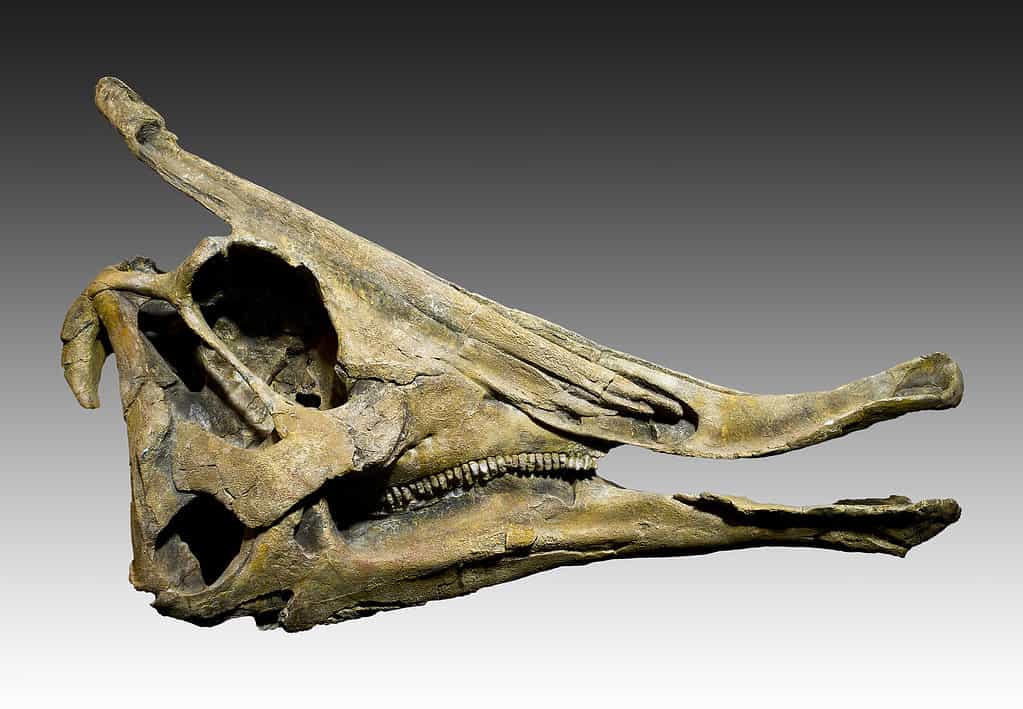
This fossil of the Saurolophus is from the
Saurolophinaesubfamily, which paleontologists often placed Hadrosaur fossils in.
©Didier Descouens, CC BY-SA 4.0 – License
Hadrosaur fossils are the most frequently identified family in California. However, paleontologists have not been able to identify every specimen. In this case, some fossils were placed in the Saurolophinae subfamily of hadrosaurs.
Beyond that, scientists could not positively confirm the dinosaur’s identity. Like other hadrosaurids, this was probably a quadrupedal herbivore. For now, that’s all we know about this specimen, making it another one of the mysterious dinosaurs that lived in California.
6. Various Unidentified Hadrosaur Dinosaurs That Lived In California

©Kevin Walsh from Bicester, England, CC BY 2.0 – License
Some fossils are only traceable to the scientific family to which they belong. That’s the case with many fossils belonging to Hadrosauridae, a group of ornithischians. Some of the fossils date back to the Late Cretaceous, specifically the Campanian and Maastrichtian ages.
7. Unidentified Theropod
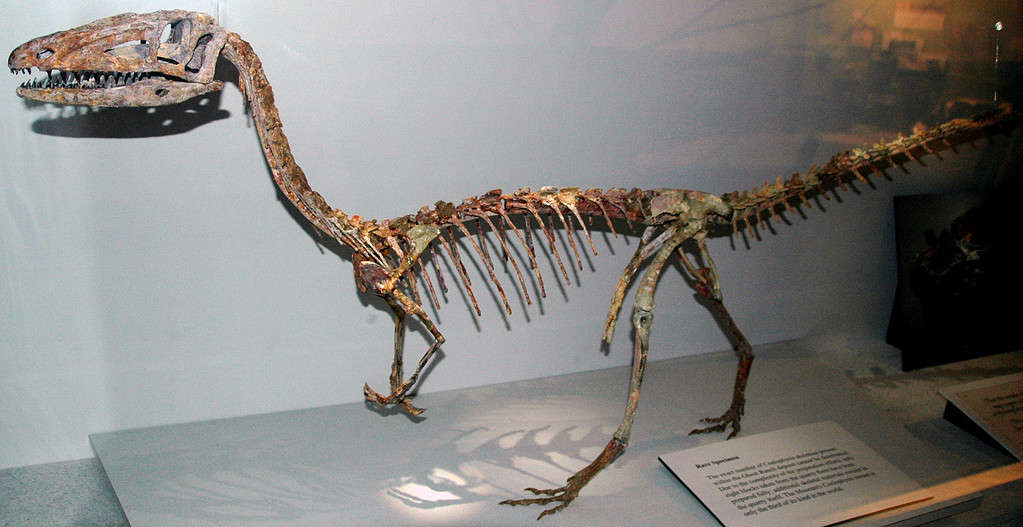
An unidentified theropod leg was discovered in California, similar to this therapod found in New Mexico.
©James St. John, CC BY 2.0 – License
Lastly, one small bone from an unidentified theropod’s leg may be the only physical evidence ever discovered of a theropod in California. Patrick J. Antuzzi found the fossil near Rocklin, and it was confirmed to be a leg of a theropod by Gregory Erickson at the University of California at Berkeley.
Paleontologists have not been able to determine the species of the theropod based on the bone fragment. However, the discovery was significant nonetheless because it provided more evidence of carnivores in the state.
Where Can You See Fossils Of Dinosaurs That Lived In California?
Although this land may not have been home to many dinosaurs, several museums exist to educate the public about the dinosaurs that lived in California. The Natural History Museum of Los Angeles County is a good place to start since it’s accessible and has plenty of exhibits.
Not only do they have digitized collections for online viewing, but you can also go into their Dinosaur Hall. This exhibit features fossils and casts of many dinosaurs, including some from out of state like Triceratops and T-Rex.
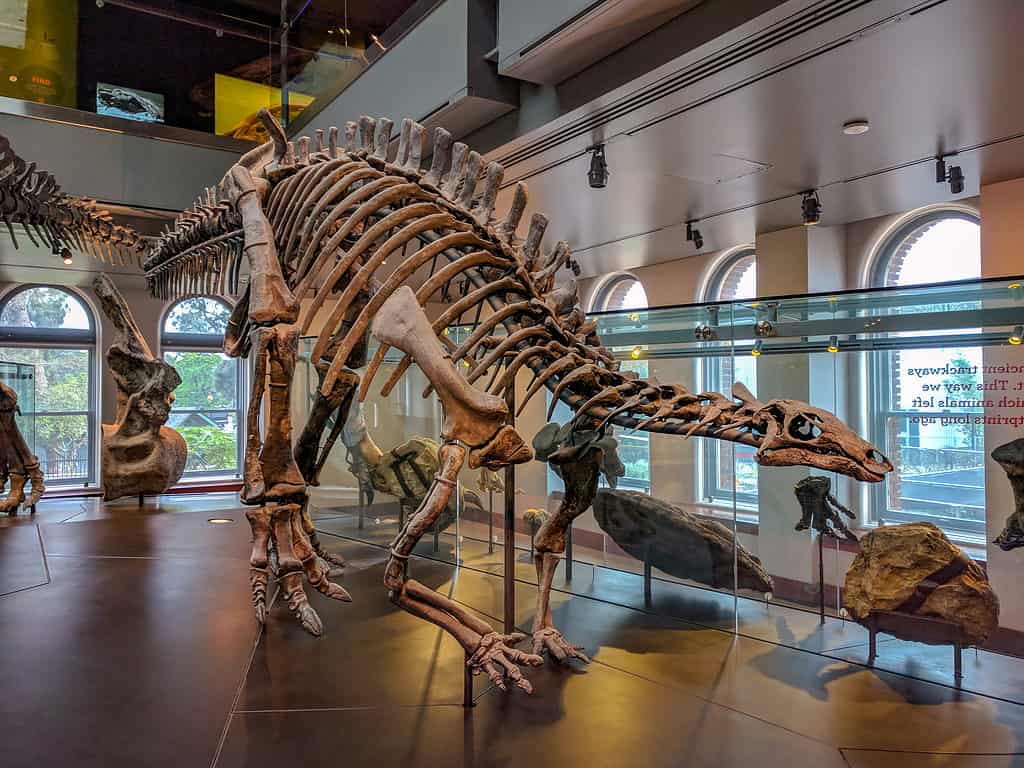
The Natural History Museum of Los Angeles County is a great place to learn about dinosaurs that lived in California and surrounding areas.
©Matthew Dillon / Flickr – License
The San Diego Natural History Museum also has a Fossil Mysteries exhibit that features dinosaur fossils as well as other creatures that lived in and around Southern California and Baja California.
Of course, if you want to go somewhere completely unique, you can always head to the La Brea Tar Pits. Make sure to check the availability of these exhibits along with their hours and costs before you head out to them.
Summary Of The 7 Dinosaurs That Lived In California
| Rank | Dinosaur | Where To Find Fossils |
|---|---|---|
| 1 | Augustynolophus morrisi | San Diego Natural History Museum; Natural History Museum of Los Angeles County; La Brea Tar Pits |
| 2 | Aletopelta coombsi | San Diego Natural History Museum; Natural History Museum of Los Angeles County; La Brea Tar Pits |
| 3 | Anchisauripus | San Diego Natural History Museum; La Brea Tar Pits |
| 4 | Grallator | San Diego Natural History Museum; Natural History Museum of Los Angeles County; La Brea Tar Pits |
| 5 | Saurolophinae | San Diego Natural History Museum; Natural History Museum of Los Angeles County; La Brea Tar Pits |
| 6 | Various Unidentified Hadrosaur Dinosaurs | San Diego Natural History Museum; Natural History Museum of Los Angeles County; La Brea Tar Pits |
| 7 | Unidentified Theropod | San Diego Natural History Museum; Natural History Museum of Los Angeles County; La Brea Tar Pits |
The photo featured at the top of this post is © Tomás Del Coro / Flickr – License / Original
Thank you for reading! Have some feedback for us? Contact the AZ Animals editorial team.






